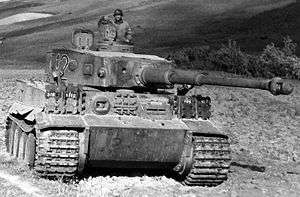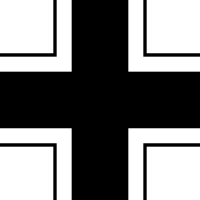8.8 cm KwK 36

The 8.8 cm KwK 36 L/56 (German: 8,8 cm Kampfwagenkanone 36 L/56) was an 88 mm electrically fired tank gun used by the German Heer during World War II. This was the primary weapon of the PzKpfw VI Tiger I tank. It was developed and built by Krupp.
Design
It shared the same caliber as the FlaK 36 88 mm gun anti-aircraft and anti-tank gun, but the KwK 36 was not derived from it. There are similarities, but the two must be considered merely parallel designs. The KwK 36 could fire the same ammunition as the FlaK 18 or 36, differing only in primer: percussion for the FlaK, electric for the KwK 36. Also the ballistics were identical and both guns had a 56 caliber barrel. The KwK 36 was built to practically the same design as the 7.5 cm and 5.0 cm guns already used in German tanks, but with the structure scaled up considerably. The breech ring was square in section and 320 millimetres (13 in) on a side. The breech block was of vertical falling wedge type and operated semi-automatically, meaning that after firing the empty cartridge case was automatically ejected, while the breech cocked itself and remained open, ready to receive the next round.
The "L56" in the designation is a traditional measurement for artillery pieces. "L" refers to the length of the interior of a gun tube (or "barrel") in proportion to the size of its bore, an important metric in determining a guns relative performance for its bore size. The inside diameter of a gun tube is considered one caliber. The designation "L56" means the barrel is 56 calibers long, or 56 times 88 mm = 4,928 mm; almost 5 metres (16 ft). Thus, it is not an absolute unit of measurement; it is a proportionate one, and thus is rarely used while considering overall dimensions. Rather, it is used to denote how much velocity a gun will generate for its bore size. The longer the tube is in relation to its bore, the higher the muzzle velocity it can generate. A longer gun barrel allows the expanding gas from the shell's charge to act on the projectile longer than a short barrel, imparting it more velocity and force. For the Tiger II's 88 mm Kwk 43 L/71, 71 times 88 mm is 6248 mm, over 6 metres (20 ft) long. Shorter tubes are most useful for indirect fire, such as howitzers or infantry support. For anti-armor purposes using traditional solid shot, a long to very-long tube is needed, to generate the necessary velocity.
Performance

The KwK 36 was very accurate, high-powered and its high muzzle velocity produced a very flat trajectory. This allowed its gunners a higher margin of error in estimating range, both helping and being partly responsible for the gun's accuracy.
In British firing trials during the war, a British gunner scored five successive hits from 1,200 yards (1,100 m) at a 16 by 18 inches (41 by 46 cm) target. Another five rounds were fired at targets moving at 15 miles per hour (24 km/h), although smoke obscured the gunners' observation, three hits were scored after directions given by the commander. The sighting system resulted in excellent firing accuracy for the 8.8 cm KwK 36 gun on the Tiger I.[1]
Capability
As the gun's performance is highly dependent on distance to target and type of ammunition loaded, it is shown in table-form. For kinetic penetration, the speed of the projectile upon impact is crucial, and air resistance will decrease the velocity of the shell as the distance to the target increases. Column 1 shows the accuracy obtained during controlled test firing to determine the pattern of dispersion, showing the best possible accuracy the gun is capable of, while column 2 show the average variation expected during practice firing due to differences between guns, ammunition and gunners; both at precisely known distances.[2] Due to errors in estimating the range and many other factors, the probability of a first shot hit under battlefield conditions was much lower than at the firing range. Observing the tracer from the first round in battle, the average, calm gunner might achieve the firing range accuracy shown in the second column with the second round fired at the same target. [2]
Panzergranate 39 (PzGr. 39)
- Type: Armour-piercing, capped, ballistic cap (APCBC) projectile with explosive filler and tracer.
- Projectile weight: 10.20 kg (22.5 lb)
- Muzzle velocity: 773 m/s (2,540 ft/s)
- Explosive filler: 0.059 kg (0.13 lb)
| Hit probability versus 2.5 x 2 m target [2] | |||
|---|---|---|---|
| Range | Penetration | 1* | 2** |
| 100 m | 132 mm | 100% | 100% |
| 500 m | 110 mm | 100% | 100% |
| 1000 m | 99 mm | 100% | 93% |
| 1500 m | 91 mm | 98% | 74% |
| 2000 m | 83 mm | 87% | 50% |
| 2500 m | n/a | 71% | 31% |
| 3000 m | n/a | 53% | 19% |
- * = testbed , ** = firing range
PzGr. 40 (APCR)
- Type: Armour-piercing, composite rigid (APCR) projectile had a sub-calibre tungsten core.
- Projectile weight: 7.30 kg (16.1 lb)
- Muzzle velocity: 930 m/s (3,100 ft/s)
| Hit probability versus 2.5 x 2 m target [2] | |||
|---|---|---|---|
| Range | Penetration | 1 | 2 |
| 100 m | 171 mm | 100% | 100% |
| 500 m | 156 mm | 100% | 100% |
| 1000 m | 138 mm | 99% | 80% |
| 1500 m | 123 mm | 89% | 52% |
| 2000 m | 110 mm | 71% | 31% |
| 2500 m | n/a | 55% | 19% |
- * = testbed , ** = firing range
Hl.39 (HEAT)
- Type: high explosive anti-tank (HEAT) round with a shaped charge.
- Projectile weight: 7.65 kg (16.9 lb)
- Muzzle velocity: 600 m/s (2,000 ft/s)
| Hit probability versus 2.5 x 2m target [2] | |||
|---|---|---|---|
| Range | Penetration | 1 | 2 |
| 100 m | 90 mm | 100% | 100% |
| 500 m | 90 mm | 100% | 98% |
| 1000 m | 90 mm | 94% | 62% |
| 1500 m | 90 mm | 72% | 34% |
| 2000 m | 90 mm | 52% | 20% |
- * = testbed , ** = firing range
Penetration comparison
| Ammunition type | Muzzle velocity (m/s) | Penetration (mm) | ||||||||||
|---|---|---|---|---|---|---|---|---|---|---|---|---|
| 100 m | 250 m | 500 m | 750 m | 1000 m | 1250 m | 1500 m | 2000 m | 2500 m | 3000 m | |||
| PzGr. 39 (APCBC) | 780 m/s (2,600 ft/s) | 162 | 158 | 151 | 144 | 138 | 132 | 126 | 116 | 106 | 97 | |
| PzGr. 40 (APCR) | 930 m/s (3,100 ft/s) | 219 | 212 | 200 | 190 | 179 | 170 | 160 | 143 | 128 | 115 | |
| Hl.39 (HEAT) | 600 m/s (2,000 ft/s) | 110 | 110 | 110 | 110 | 110 | 110 | 110 | 110 | 110 | 110 | |
See also
- 88mm KwK 43 L/71 - the direct successor to this gun, and the one mounted on the Tiger II
- 8.8 cm Flak 18/36/37/41, the prominent anti-aircraft and anti-tank weapon the 8.8 cm KwK 36 is often confused with
Weapons of comparable role, performance, and era
- British Ordnance QF 17-pounder
- Soviet 85 mm D-5T/ZiS-S-53
- United States 90 mm Gun M3
References
- Bibliography
- Green Michael, Panzers at War. London: Zenith Press, 2005. ISBN 0-7603-2152-3
- Thomas L. Jentz, Germany's Tiger Tanks: Tiger I and Tiger II - Combat Tactics. London: Schiffer Publishing Ltd, 1996. ISBN 0-7643-0225-6
External links
| Wikimedia Commons has media related to 8.8 cm KwK 36. |
